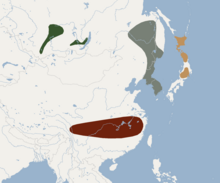| Long-tailed myotis | |
|---|---|
| Conservation status | |
 Least Concern (IUCN 3.1) | |
| Scientific classification | |
| Domain: | Eukaryota |
| Kingdom: | Animalia |
| Phylum: | Chordata |
| Class: | Mammalia |
| Order: | Chiroptera |
| Family: | Vespertilionidae |
| Genus: | Myotis |
| Species: | M. longicaudatus |
| Binomial name | |
| Myotis longicaudatus Ognev, 1927 | |

| |
| M. longicaudatus subspecies: M. l. eniseensis M. l. longicaudatus M. l. kaguyae | |
| Synonyms | |
|
Myotis frater longicaudatus | |
The long-tailed myotis (Myotis longicaudatus) is a species of vesper bat found in northern and eastern Asia.
Taxonomy
Previously thought to be a subspecies of the fraternal myotis (M. frater), it was split as a distinct species by a 2015 study based on molecular evidence. This has also been followed by the American Society of Mammalogists, the IUCN Red List, and the ITIS. The study found it to be basal to a clade containing M. frater, the reddish myotis (M. soror), and Daubenton's bat (M. daubentonii). Other studies have also recovered the Bocharic myotis (M. bucharensis) as its sister species.
Distribution and habitat
It has a wide distribution across North Asia and East Asia east of the Altai Mountains, from southern Siberia and Mongolia south to Korea and Japan. It is found in a wide range of habitats, both natural and artificial, and is thus considered a generalist species. In Japan, it has been observed roosting in tree cavities, tunnels, bridges, and buildings. It has been observed foraging along streets in Hokkaido.
Description
It is a relatively small bat with dark brown wings. Its hind legs are slightly longer than other Myotis species, and the tail length is similar to the head-to-body length. Its pelage is dorsally dark brown and ventrally dark ivory. Its ears are short, dark brown in color, and have a pointed tragus.
Behavior
During the summer, this species may sometimes share roosting caves with the eastern water bat (M. petax); however, both species hibernate separately during the winter.
Status
Due to its wide range and generalist nature, it is not thought to have any major threats. However, it may be threatened by roadkills in Hokkaido, and in general may be at risk from forest degradation and disturbances to roosting sites. Despite a wide distribution, it is a naturally rare species.
References
- ^ Vincenot, C.E.; Preble, J.H.; Collazo, A.M. (2021). "Myotis longicaudatus". IUCN Red List of Threatened Species. 2021: e.T85566977A85566980. doi:10.2305/IUCN.UK.2021-2.RLTS.T85566977A85566980.en. Retrieved 1 February 2022.
- ^ "Explore the Database". www.mammaldiversity.org. Retrieved 2022-02-01.
- ^ RUEDI, MANUEL; CSORBA, GÁBOR; LIN, LIANG-KONG; CHOU, CHENG-HAN (2015-02-20). "
Molecular phylogeny and morphological revision of Myotis bats(Chiroptera: Vespertilionidae) from Taiwan and adjacent China
". Zootaxa. 3920 (2): 301–342. doi:10.11646/zootaxa.3920.2.6. ISSN 1175-5334. PMID 25781252. - "ITIS - Report: Myotis longicaudatus". www.itis.gov. Retrieved 2022-02-01.
- KAZAKOV, DENIS V.; ARTYUSHIN, ILYA V.; KHABILOV, TOLIBJON K.; TADZHIBAEVA, DILBAR E.; KRUSKOP, SERGEI V. (2020-11-12). "Back to life and to taxonomy: new record and reassessment of Myotis bucharensis (Chiroptera: Vespertilionidae)". Zootaxa. 4878 (1): 129–144. doi:10.11646/zootaxa.4878.1.5. ISSN 1175-5334. PMID 33311169. S2CID 228879012.
- ^ JO, YEONG-SEOK; BACCUS, JOHN T.; KOPROWSKI, JOHN L. (2018-11-18). "Mammals of Korea: a review of their taxonomy, distribution and conservation status". Zootaxa. 4522 (1): 1–216. doi:10.11646/zootaxa.4522.1.1. ISSN 1175-5334. PMID 30486139. S2CID 54145825.
| Taxon identifiers | |
|---|---|
| Myotis longicaudatus | |